The foundation of any smart city requires an innovative and robust communication infrastructure. Many research communities envision free-space optical communication (FSO) as a promising backbone technology for the services and applications provided by such cities. However, the channel through which the FSO signal travels is the atmosphere. Therefore, the FSO performance is limited by the local weather conditions. The variation in meteorological variables leads to variations of the refractive index along the transmission path. These index inhomogeneities (i.e., atmospheric turbulence) can significantly degrade the performance of FSO systems. The effect of atmospheric turbulence on FSO systems is a considerable challenge. Such turbulence can produce beam scintillation, spreading, and wandering, resulting in a significant reduction in BER performance and the inability to use the communication link.
- free space optical communication
- atmospheric turbulence
1. Atmospheric Turbulence

-
When the turbulence cells’ diameters are smaller than the laser beam diameter, the laser beam bends and becomes distorted. Small differences in the arrival times of various components of the beam wavefront cause constructive and destructive interference, resulting in temporal variations in the laser beam intensity at the receiver. This effect is known as scintillation, Figure 1a.
-
If the size of the air turbulence cell is larger than the beam diameter, it can bend the optical path. Figure 1b shows how the beams (solid rays) leaving the laser source are deflected as they go through the large air cell, arriving off-axis rather than on-axis as expected in the absence of turbulence.
2. Mathematical Analysis of Atmospheric Turbulence
2.1. Refractive Index Structure Parameter
- C2n
-
with the meteorological parameters.
- 47];
-
This model chan help correlate the changes in the atmospheric turbulences been validated for a similar coastal area called Negev area, as shown in strength Figure 2. Negev is wapproxith the meteorological parameters.mately 400 km from the study area, NEOM, and has a similar landscape;
-
This model can help correlate the changes in the atmospheric turbulence strength




where W is the weight function, T is the air temperature (° K), H is the relative humidity (%), and v is the wind speed (m/s). This model is valid under specific limits of macroscale parameters, specifically, the temperature (from 9 to 35 °C), relative humidity (from 14% to 92%), and wind speed (from 0 to 10 m/s) [11][48]. The weight function W is calculated based on a temporal hour that relates the actual time to sunrise and sunset, as indicated in Table 1.

where HT HT is the temporal hour, Hactual Hactual is the actual time, Hsunrise Hsunrise is the sunrise time and Hsunset Hsunset the sunset time. The typical values of C2n are C2n=0.5×10−14m−23 for weak turbulence, C2n=2×10−14m−23 for moderate turbulence, and for stroC2ng turbulence [12][13].=5×10−14m−23
| Temporal Hour Interval |
W | Temporal Hour Interval |
W |
|---|
| Until −4 | 0.11 | 5 to 6 | 1.00 |
| −4 to −3 | 0.11 | 6 to 7 | 0.90 |
| −3 to −2 | 0.07 | 7 to 8 | 0.80 |
| −2 to −1 | 0.08 | 8 to 9 | 0.59 |
| −1 to 0 | 0.06 | 9 to 10 | 0.32 |
| Sunrise 0 to 1 | 0.05 | 10 to 11 | 0.22 |
| 1 to 2 | 0.10 | 11 to 12 | 0.10 |
| 2 to 3 | 0.51 | 12 to 13 | 0.08 |
| 3 to 4 | 0.75 | Over 13 | 0.13 |
| 4 to 5 | 0.95 |
2.2. Scintillation
4.2. Scintillation
, is defined as the normalized variance of the light wave intensity:

where I is a time series of intensity measurements, and the angle brackets denote a time average. The relation between the refractive index structure parameter and σ2I is [14][52]

where k=2π/λ represents the wave number, λ is the wavelength, and L is the transmission distance. The scintillation index is commonly used to classify intensity fluctuation, and its values for weak, moderate, and strong fluctuations are σI<1, σI∼1, and , respectively [14]. Generally, scintillation can result in a high BER.σI>1
2.3. Beam Spreading
4.3. Beam Spreading
, is defined as follows [39]:

where w(L) is the beam waist at a propagation distance L.

where w0 is the initial beam waist at L=0 m.

